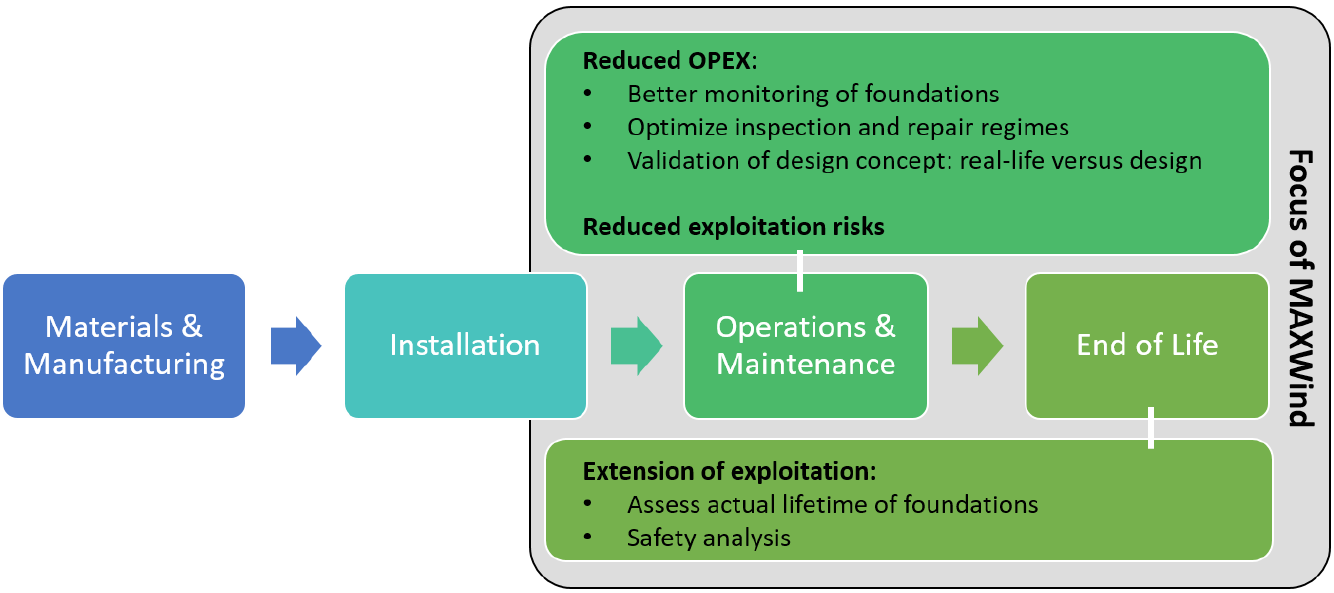
MAXWind – MAintenance, Inspection and EXploitation Optimization of Offshore Wind Farms subjected to Corrosion-Fatigue
Number of partners: 4
Coordinator: University of Ghent
Partners: VUB, ULiège, Sirris
Project type: Fundamental research
Start date: 01/03/2020
Duration: 4 years
Budget: 2.222.915 €
Funded by the Energy Transition Fund (ETF)

Partners

Project context
In April 2018, it was publicly announced that Belgium will double the area of its North Sea waters made available to offshore wind parks after 2020. After 2020, a new, 221-squarekilometre area near French waters is planned. This strategy clearly emphasizes the support of the Belgian government for wind energy as an important energy supplier for the future. In the near future there will be parks with different lifetime and this requires a sound lifetime assessment procedure to ensure the good functioning of the wind turbines and secure the energy supply. The steel support structures (jackets, monopiles) are subjected to both fatigue and corrosion, impacting their lifetime. There is a need for accurate lifetime assessment tools that can help offshore wind farm owners and operators to optimize the wind farm in the future lowering the Levelized Cost of Energy (LCoE) below 60€/MWh. This is of importance for the farms that are currently in operation and need an optimized maintenance strategy and possible extension of their exploitation, as well as for new projects which can also benefit from lifetime assessment tools in the design process.
Project description
Fatigue and corrosion are critical failure causes of offshore wind support structures. The low accessibility and high inspection/repair costs of large structures in corrosive environments is motivating remote monitoring and optimized inspection and maintenance plans, based on continuous assessment of the structure’s reliability.
Due to the time-variant uncertainties associated with corrosion, applied loads, stress prediction and modelling of the deterioration mechanisms, a more advanced lifecycle reliability assessment is necessary to assess the structural safety and to support decision making. The project aims to reduce the uncertainties by combining inspection and monitoring data (about cracks and corrosion), load measurements and estimates (stresses, wind, wave) and improved material property models.
This information can be employed to regularly update the failure probabilities and thus structural reliability. This also necessitates to have reliable models that can simulate the real behavior of the structure to predict qualitatively and quantitatively the degradations due to corrosion and fatigue. These numerical models will be calibrated with available and new field data (unique long-term load measurements on offshore wind turbines).
The focus of MAXWind will be on monopile foundations, as these are currently the most used type of foundation in Belgian waters and there is a large amount of data available on these type of foundations. However, the established methodology can be extended to include other foundation types like jacket structures and floating foundations.
Project objectives
The global goal is to get a much better estimation of the remaining life of in-service wind turbines and to derive optimized inspection and maintenance plans for a group of similar structures. This will make it possible not only to define the optimal inspection plan, leading to reduced maintenance costs while ensuring functionality and safety, but also to calibrate the safety factors of design standards attempting to enhance the fatigue analyses in the design stage.
The following (fundamental) knowledge gaps are identified and will be tackled in this proposal:
- What are the interactive effects of corrosion and fatigue load on crack initiation and propagation at welded joints?
- Can we develop a validated method to update the failure probabilities of structural details where fatigue occurs (welded joint) considering the collected environmental data and those obtained from inspection/maintenance (corrosion, cracks)?
- Can the methodology for a single welded joint be extended to the other non-monitored joints and to the entire structure?
- Can we extrapolate the knowledge learned from a few monitored/inspected OWT structuresto update the probability of failure of similar structures in the entire wind farm?
- How much cost reduction is expected once the optimal maintenance plan is defined?
The following project goals have been set:
- In-field measured data
- Numerical routines for analysis and filtering of load data
- Validated model for non-linear damage accumulation
- Integrated model for combination of corrosion and fatigue
- Methodology for integration of corrosion and crack size information in smart S-N curve
- Optimized virtual sensing methodology for one structure and extension of Fleet leader concept for structural differences
- Structural Reliability and Risk-based Maintenance Methodology
Impact in Belgium
To meet the objectives related to renewable energy, wind energy plays an important role. If wind energy has a large share in the total energy production, wind turbine parks will need to provide reliable energy and this independent of their lifetime. Currently, inspection, maintenance and repair actions induce large costs and it is to date unclear how this will evolve with higher lifetime. Costs directly related to corrosion are hard to assess, as damage results from the interplay of fatigue and corrosion. The NeSSIE project (North Sea Sollutions for Innovations for Corrosion in Energy), in which OWI-Lab was involved through Sirris, studied the economic impact of corrosion on marine structures, including off shore energy structures. From this study, it can be extrapolated that the cost of the corrosion repairs in splash zone for the Belgium wind farms is around 2.75m€ every year. Other indirect costs are even much higher, but very hard to assess. These are all included in O&M costs. Possible extension of exploitation might offer great benefits and cost reductions, on the basis that safety and energy supply can be guaranteed. The figure below illustrates the different stages of the lifecycle of offshore wind parks and indicates the focus points of the MAXWind project.
